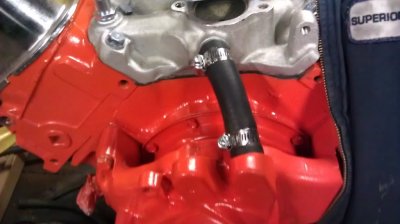77 K20
Full Access Member
- Joined
- Nov 9, 2012
- Posts
- 3,076
- Reaction score
- 3,051
- Location
- Montana
- First Name
- Mike
- Truck Year
- 1977
- Truck Model
- K20 5" lift
- Engine Size
- HT383 fuel injected
So I installed a GM HT383 in August of 2014. I've been thru 2 winters with it so far and it runs like crap in cold weather. Pretty much anything below 37 degrees or so. It will start ok but then cough sputter and shake while at idle and at low speed. There is also hesitation right off of idle also. However once it is fully warm it runs great.
I've run 2 different quadrajet carburetors on it and am now running a Edelbrock TBI fuel injection unit on it. All of them behaved about the same when cold. The fuel injection is the best out of the 3, but still pretty lousy.
I used to think is something was wrong- but now I'm thinking that maybe it is just by design? I have read that for some reason votec heads do not have an exhaust crossover passage for the intake manifold to warm them. I'm thinking this is why my old 400 ran so much better when it was cold. Would you guys agree with that?
The 383 has a GM performance 12496820 manifold which is rumored to be made by Edelbrock.
How much would another intake manifold help to make the engine run better when cold? Edelbrock makes one for vortec heads:
Of course Edelbrock is going to recommend this manifold- as they said the GM manifold won't work well because it is a spread bore manifold and the TBI unit is a square bore. I'm currently running an Edelbrock aluminum carb adapter on it.
Before I used the above adapter I ran the one below and it ran worse. I'm thinking because it pretty much made the dual plane intake manifold into a single plane.
So just wanted to pick your guys's brains and see what you thought. Getting sick of spending money on it, and now that it is getting to be summer I won't worry much about it for 6 months or so.
Of course in hindsight I should have skipped the TBI unit and maybe bought a multiport setup for even more $$$ instead. But my dad's 1987 K5 Blazer with TBI on it ran great in winter. I stupidly thought the same would apply here.
I've run 2 different quadrajet carburetors on it and am now running a Edelbrock TBI fuel injection unit on it. All of them behaved about the same when cold. The fuel injection is the best out of the 3, but still pretty lousy.
I used to think is something was wrong- but now I'm thinking that maybe it is just by design? I have read that for some reason votec heads do not have an exhaust crossover passage for the intake manifold to warm them. I'm thinking this is why my old 400 ran so much better when it was cold. Would you guys agree with that?
The 383 has a GM performance 12496820 manifold which is rumored to be made by Edelbrock.
You must be registered for see images attach
How much would another intake manifold help to make the engine run better when cold? Edelbrock makes one for vortec heads:
You must be registered for see images
Of course Edelbrock is going to recommend this manifold- as they said the GM manifold won't work well because it is a spread bore manifold and the TBI unit is a square bore. I'm currently running an Edelbrock aluminum carb adapter on it.
You must be registered for see images
Before I used the above adapter I ran the one below and it ran worse. I'm thinking because it pretty much made the dual plane intake manifold into a single plane.
You must be registered for see images attach
So just wanted to pick your guys's brains and see what you thought. Getting sick of spending money on it, and now that it is getting to be summer I won't worry much about it for 6 months or so.
Of course in hindsight I should have skipped the TBI unit and maybe bought a multiport setup for even more $$$ instead. But my dad's 1987 K5 Blazer with TBI on it ran great in winter. I stupidly thought the same would apply here.
Last edited:


